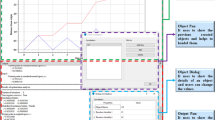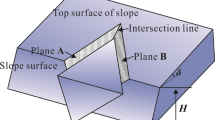Abstract
This study proposes a probabilistic approach based on blind data theory and a k-means clustering algorithm to analyze the wedge stability problem considering multiple failure modes. The method evaluates the stability of the wedge by constructing a blind data model that can comprehensively consider the various uncertainties of the wedge parameters. The construction of the blind data evaluation model of wedge stability is described, and the blind evaluation model used to determine the wedge stability with wedge failure dominated by a prone-sliding face and double-face failure is given. The model is applied to analyze the stability of a classical double-face wedge. The results are compared with the probability of failure evaluated by a Monte-Carlo simulation, as well as the results obtained from deterministic analysis, including the mean safety factor and SWEDGE numerical analysis methods. The probability distribution for the safety factor of the wedge determined by this method is fairly consistent with those from the Monte-Carlo simulation method, verifying the reliability and efficiency of the new method. Finally, the method is applied to the stability evaluation of the wedge in Huludao city, Liaoning Province, China. The probability of safety factors less than 1 is 89.8%, and the probability that the safety factor is less than 1.2 is 100%, which is consistent with the actual situation. This result demonstrates that the blind data model for evaluating wedge stability exhibits good generalization performance.










Similar content being viewed by others

References
Akbari MG, Rezaei A (2010) Bootstrap testing fuzzy hypotheses and observations on fuzzy statistic. Expert Syst Appl 37(8):5782–5787
Bahsan E, Liao H-J, Ching J, Lee S-W (2014) Statistics for the calculated safety factors of undrained failure slopes. Eng Geol 172:85–94
Budetta P, De Luca C (2015) Wedge failure hazard assessment by means of a probabilistic approach for an unstable sea-cliff. Nat Hazards 76(2):1219–1239
Chen X, Gong W, Qiu J, Yu P, Wang D (2016) Reliability analysis of slope based on blind data theory. Chin J Rock Mech Eng 35(6):1155–1160
Cheng H, Zhu H, Crow ML, Sheble GB (2004) Flexible method for power network planning using the unascertained number. Electr Power Syst Res 68(1):41–46
Cui F (2015) Petrogenesis of Mesozoic granitoids and crustal evolution in Xingcheng area, western Liaoning Province Jilin University
Duzgun HSB, Bhasin RK (2009) Probabilistic stability evaluation of Oppstadhornet rock slope, Norway. Rock Mech Rock Eng 42(5):729–749
Giasi CI, Masi P, Cherubini C (2003) Probabilistic and fuzzy reliability analysis of a sample slope near Aliano. Eng Geol 67(3–4):391–402
Hoek ET, Bray JW (1981) Rock slope engineering (the 3rd edition). Institute of Mining and Metallurgy, London
Jia H, He H (2003) Analysis of fuzzy-random reliability of slope atability. Rock Soil Mech 24(4):657–660
Jiang Q, Liu X, Wei W, Zhou C (2013) A new method for analyzing the stability of rock wedges. Int J Rock Mech Min Sci 60:413–422
Jiang Q, Qi Z, Wei W, Zhou C (2015) Stability assessment of a high rock slope by strength reduction finite element method. Bull Eng Geol Environ 74(4):1153–1162
Johari A, Lari AM (2016) System reliability analysis of rock wedge stability considering correlated failure modes using sequential compounding method. Int J Rock Mech Min Sci 82:61–70
Kumsar H, Aydan O, Ulusay R (2000) Dynamic and static stability assessment of rock slopes against wedge failures. Rock Mech Rock Eng 33(1):31–51
Li D, Zhou C, Lu W, Jiang Q (2009) A system reliability approach for evaluating stability of rock wedges with correlated failure modes. Comput Geotech 36(8):1298–1307
Li WX, Mei SH (2004) Fuzzy system method for the design of a jointed rock slope. Int J Rock Mech Min Sci 41(3):569–574
Liu KD, Wu HQ, Pang YJ (1999) Mathematics treatment andapplication of uncertainty information. Science Press, Beijing
Liu L, Cheng Y (2016) Efficient system reliability analysis of soil slopes using multivariate adaptive regression splines-based Monte Carlo simulation. Comput Geotech 79:41–54. https://doi.org/10.1016/j.compgeo.2016.05.001
Liu T, Deng J, Zheng J, Zheng L, Zhang Z, Zheng H (2017) A new semi-deterministic block theory method with digital photogrammetry for stability analysis of a high rock slope in China. Eng Geol 216:76–89
Low B, Einstein H (1992) Simplified reliability analysis for wedge mechanisms in rock slopes. In: Proc., 6th Int. Symp. on landslides. Balkema, Rotterdam The Netherlands, pp 499–507
Low BK (1999) Reliability analysis of rock wedges - closure. J Geotech Geoenviron Eng 125(6):539–539
Low BK (2008) Efficient probabilistic algorithm illustrated for a rock slope. Rock Mech Rock Eng 41(5):715–734
Luo N, Bathurst RJ, Javankhoshdel S (2016) Probabilistic stability analysis of simple reinforced slopes by finite element method. Comput Geotech 77:45–55
Ma L, Yan H, Zhang Y (2011) Effectiveness evaluation of construction Enterprise information systems planning based on unascertained number. Proc Eng 15:4745–4750
MacQueen J (1967) Some methods for classification and analysis of multivariate observations. In: Proceedings of the fifth Berkeley symposium on mathematical statistics and probability. vol 14. Oakland, CA, USA., pp 281–297
Park H, Um J, Woo I, Kim JW (2012) The evaluation of the probability of rock wedge failure using the point estimate method. Environ Earth Sci 65(1):353–361
Park H, West TR (2001) Development of a probabilistic approach for rock wedge failure. Eng Geol 59(3–4):233–251
Park H, West TR, Woo I (2005) Probabilistic analysis of rock slope stability and random properties of discontinuity parameters, interstate highway 40, western North Carolina, USA. Eng Geol 79(3–4):230–250. https://doi.org/10.1016/j.enggeo.2005.02.001
Reddy D, Jana PK (2012) Initialization for K-means clustering using Voronoi diagram. Proc Technol 4:395–400
Rocscience L (2001) SWEDGE-probabilistic analysis of the geometry and stability of surface wedges
Shen H, Abbas SM (2013) Rock slope reliability analysis based on distinct element method and random set theory. Int J Rock Mech Min Sci 61:15–22
Tao Z, Zenghui W, Ruichang Y (2005) Study on model of onset of nucleate boiling in natural circulation with subcooled boiling using unascertained mathematics. Nucl Eng Des 235(21):2275–2280
Tian S, Chen JH, Dong LJ (2017) Rock strength interval analysis using theory of testing blind data and interval estimation. J Cent South Univ 24(1):168–177
Tun YW, Pedroso DM, Scheuermann A, Williams DJ (2016) Probabilistic reliability analysis of multiple slopes with genetic algorithms. Comput Geotech 77:68–76
Wang X, Wang L, Qiu Z (2014) A feasible implementation procedure for interval analysis method from measurement data. Appl Math Model 38(9–10):2377–2397
Wang Y (2014) The ancient tsunami event and sedimentary environment of the mesoproterozoic dahongyu formation in xingcheng area. Jilin University, Liaoning
Weng M, Lo C, Wu C, Chuang T (2015) Gravitational deformation mechanisms of slate slopes revealed by model tests and discrete element analysis. Eng Geol 189:116–132
Wittke W (1967) Influence of the shear strength of the joints on the design of prestressed anchors to stabilize a rock slop. Geotech Conf 4(11):311–318
Wu S, Zhou Y, Gao Y, Misra A (2012) Research on construction method of stochastic joints 3D-network model of equivalent rock mass. Chin J Rock Mech Eng 31(Supp 1):3082–3090
Zhang C (2016) Nonlinear simulation of resonant sloshing in wedged tanks using boundary element method. Eng Anal Boundary Elem 69:1–20
Acknowledgements
This work was supported by the National Natural Science Foundation of China for Youths (grant no. 41202197) and the Key Projects of the National Natural Science Foundation of China (grant no. 41330636).
Author information
Authors and Affiliations
Corresponding author
Rights and permissions
About this article
Cite this article
Ma, Z., Qin, S., Chen, J. et al. A probabilistic method for evaluating wedge stability based on blind data theory. Bull Eng Geol Environ 78, 1927–1936 (2019). https://doi.org/10.1007/s10064-017-1204-3
Received:
Accepted:
Published:
Issue Date:
DOI: https://doi.org/10.1007/s10064-017-1204-3



